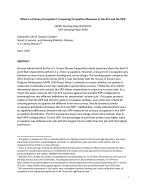What is a Primary Occupation? Comparing Occupation Measures in the ACS and the SIPP
What is a Primary Occupation? Comparing Occupation Measures in the ACS and the SIPP
Introduction
Surveys administered by the U.S. Census Bureau frequently include questions about the kind of work that respondents perform (i.e., their occupation). However, measures for occupation vary between surveys due to question wording and survey design. This working paper compares the 2013 American Community Survey (ACS) 1-year estimates with the Survey of Income and Program Participation (SIPP) 2014 Panel, Wave 1 estimates to assess whether occupation is measured consistently across two nationally-representative surveys. While the ACS collects information about only one job, the SIPP allows respondents to report up to seven jobs. As a result, this paper assesses the one ACS measure against two possible SIPP configurations stemming from two different definitions for respondents’ primary job. This paper presents evidence that the SIPP and the ACS capture occupation similarly, even when the criteria for selecting primary occupation are different in the two surveys. Results showed a similar occupation distribution between the ACS and SIPP. Additionally, results indicated there were no significant differences between the two SIPP measures for primary occupation in the SIPP occupation distribution. The ACS measured a lower percentage of part-time workers than in both SIPP configurations. For the SIPP, the percentage of part-time workers was higher when occupation was defined as the job with the longest tenure rather than the job with the highest total hours.




